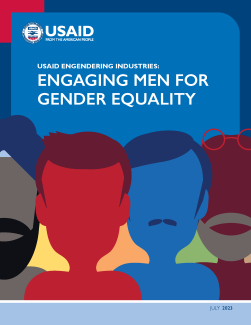Engaging Men for Gender Equality Training Manual
Who Should Use This Training Manual
This training manual is designed to be used by staff members of organizations or companies within traditionally male-dominated industries, with a particular focus on organizations participating in USAID’s Engendering Industries program. It could also be used and/or adapted by gender equality organizations wishing to train facilitators on engaging men for gender equality. It could also be delivered as a direct training by gender equality facilitators in a workplace setting. It is designed to support the delivery of gender-transformative group education processes to men and women.
Gender Inclusivity
Throughout the training manual, “men” and “women” refer to all people who self-identify as such, including both cisgender and transgender men and women. Although the activities can be relevant for persons of all gender identities, they were intentionally designed to expose and interrogate the inequities within the gender binary
and, therefore, generally work within these structures.
As such, this training manual addresses the gendered experiences of men and women and the transformation of harmful gender stereotypes and norms. It acknowledges the limitations of the gender binary and the marginalization that nonbinary, gender-nonconforming, and queer people experience. Users of the manual are encouraged, therefore, to be inclusive of all gender identities of training participants and sensitive to the intersectionality of participants’ gender identities (cisgender, transgender, and nonbinary) with other aspects of their identities, such as sexual orientation, race/ethnicity, socioeconomic status, and religious affiliation.
The Goal of this Training Manual
The manual aims to foster reflection, dialogue, and analysis on how gender norms create inequality and disparities in rights, opportunities, and access to resources for men, women, and nonbinary persons, in all their diversity, within organizations. It also illustrates how gender norms reinforce patriarchal values and practices in the workplace.
The manual seeks to engage men through reflection and dialogue that promote healthy masculinity and attitudes and practices that reflect the values of equality, respect, collaboration, and allyship with women.


